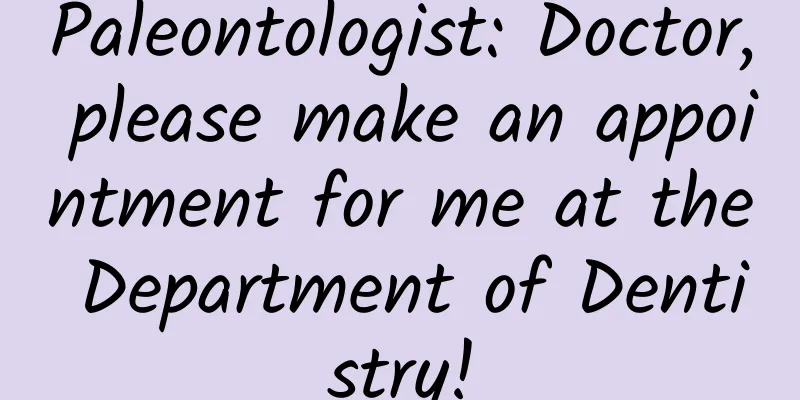Paleontologist: Doctor, please make an appointment for me at the Department of Dentistry!

|
Produced by: Science Popularization China Author: Komeichiren Producer: China Science Expo Today is World Oral Day. In addition to paying attention to your oral problems, there are some oral problems that are also worthy of attention, but they belong to ancient organisms. Mammoths, Tyrannosaurus Rex, Megalodon... When it comes to ancient creatures, what impresses us most is probably their unique and majestic teeth, in addition to their huge bodies. These naturally evolved teeth are also one of the keys to their survival and reproduction. In fact, dental problems have existed on Earth for hundreds of millions of years. Since fish in the Devonian and Carboniferous periods had teeth, dental diseases have always been with animals. "Dragon" teeth: If they are broken, they can be replaced, which is admirable, but you still need to see a dentist occasionally No ancient creature is more famous than dinosaurs. Dinosaurs were the most prosperous vertebrates in the Mesozoic Era, dominating the global terrestrial ecosystem for 140 million years, leaving behind many huge skeleton fossils. Tyrannosaurus Rex is one of the largest carnivorous dinosaurs. It has about 60 strong serrated teeth in its mouth, up to 30 cm long, like a chisel, which is daunting. These huge teeth played an indispensable role in the hunting activities of dinosaurs. The front teeth of Tyrannosaurus Rex were closely arranged to bite the prey and withstand the pulling of the prey when struggling, while the side teeth were more widely spaced to tear the meat of the prey after killing it. In the process of biting meat and removing bones, the teeth have to withstand considerable pulling, collision and friction, which can cause wear and even breakage. A Tyrannosaurus Rex preying on a small ornithischian dinosaur (model), showing that they had huge heads and teeth compared to humans. Image credit: Block Club Chicago Fortunately, dinosaurs have a secret passed down from their ancestors - tooth replacement. Like sharks, dinosaurs' teeth can regenerate and replace. When replacing, the crown exposed to the outside falls off first, and the root wrapped in the gums is absorbed and replaced by new teeth. Most dinosaurs replaced their teeth very quickly, with some adult dinosaurs replacing all their teeth in two months, replacing thousands of teeth in their lifetime. Such a frequent replacement rate would hardly give bacteria time to form caries, so dental diseases are rarely found in the tooth fossils of animals such as dinosaurs that can replace their teeth. The state of teeth in the mouth of a dinosaur. They were replaced very quickly (diagram) Image credit: Adelphi University But there are always exceptions. These unlucky ones are not dinosaurs, but their relatives, Mosasaur and Ichthyosaur. These animals with "dragon" in their names belong to the same group - Sauropoda. Animals in this group have the ability to replace teeth like dinosaurs, but being able to replace teeth does not mean that they can sit back and relax. On a Mosasaur skull collected in a Belgian museum, there were obvious signs of infection in its lower jaw: bone hyperplasia and necrosis near the root of a tooth in the lower jaw, the root canal of the tooth seemed to be full of bacteria, there were signs of pus overflow, and there were undoubted caries on the edge of the dentin. A clear U-shaped cavity also appeared on the inner side of a front tooth of an ichthyosaur fossil numbered AMF98273 from Australia. Just like human caries, it penetrated the enamel layer into the dentin underneath, leaving a cavity inside, which was obviously related to bacterial infection. Don’t mention it, it hurts just looking at it! Diseased tooth of ichthyosaur specimen AMF98273, where DC indicates the caries cavity Image source: Reference [2] Why do they still get caries if they can replace their teeth? This is related to their bad "living habits". Mosasaurs and ichthyosaurs lived in water, just like whales and dolphins today, feeding on fish, squids, etc. in the water. In order to catch these creatures, they had a large number of teeth, each of which was very small and densely arranged on the tooth socket to increase the friction when biting the prey and prevent the prey from escaping. However, this arrangement leaves little space between the tooth roots, and like humans, they only have a narrow crack-like gap between their teeth, which is very easy for food debris to get stuck in. Humans all know how unpleasant it is to have food stuck in your teeth, but these aquatic animals don't have hands, let alone dental floss, so the debris can't be removed and can only rot in the gaps between their teeth, providing space for bacteria to multiply and cause tooth decay. At the same time, because their teeth do not need to cut food like carnivorous dinosaurs, they only need to bite, which leads to less wear and tear and does not need to be replaced frequently. Therefore, the speed at which ichthyosaurs and mosasaurs replace their teeth is also relatively slow. With abundant residues and narrow spaces, bacteria multiply in large numbers and cannot be removed by tooth replacement, so it is natural for caries to occur. Teeth with caries will lose their activity, cannot fall off or absorb, and lose the ability to be replaced throughout life. Fortunately, both animals have hundreds of teeth in their mouths, and the loss of a small tooth does not have much impact on them, but it is different for another type of creature - mammals including humans. Animal teeth: can only be replaced once in a lifetime, dental disease will cause endless suffering Cats, dogs and other mammals are the best playmates in human life, but few people know that they also change their teeth. Like humans, most mammals have "double sets of teeth", that is, they have milk teeth when they are young and replace them with permanent teeth when they are adults. Some mammals (such as whales) have single sets of teeth, that is, they do not change their teeth throughout their lives. But no matter what kind of mammal it is, they have a limited number of teeth, and a set of teeth will accompany them for decades, and very few do not suffer from dental diseases. Among extinct mammals, there are also many cases of dental caries and other problems. Dental caries have been found in the tooth fossils of mammoths, mastodons, and early European cave bears. Dental caries are most common in elephants because elephants have a long lifespan, which gives bacteria plenty of time to corrode the tooth surface and cause dental caries. An irregular depression about 6 mm deep was found above the crown of a mammoth fossil molar. The mouth of the cavity is oval, 3 cm wide, and the surface is irregularly eroded. This cavity is 9 times larger than a human tooth. The other tooth in question belonged to a close relative of the mammoth, the American mastodon (Mastodon americanus). This tooth had cavities on the upper front side and on the side close to the lip. It was the second-to-last molar in the lower left jaw and played an important role in chewing grass. Interestingly, the wear pattern of this tooth is different from that of other teeth. The side close to the lip has less wear, while the side facing the tongue has more wear. This shows that the mastodon consciously used the tooth position away from caries, indicating that it may have felt pain due to tooth decay when it was alive. At the same time, the surface of the teeth adjacent to the diseased tooth also had defects, and the nearby gums also proliferated and changed, indicating that severe caries had spread to the adjacent teeth. This is also true for humans. If you are afraid of dentists and take painkillers to solve toothaches, the caries that have not been treated in time will become more and more serious, eventually causing alveolar bone changes, fistulas, etc., causing bacteria to spread to other teeth, turning a mouthful of good teeth into bad teeth. Therefore, once toothache occurs, it is best to seek timely treatment after the pain subsides. After all, under the effect of anesthetics, tooth repair will not be particularly painful. American Mastodon (Mastodon americanus) Image source: WHIO-TV The teeth of the mastodon were broad, flat, and multi-pointed, making them suitable for grinding plants. Image source: University of Kentucky The reason why mammals develop dental caries is also closely related to the retention and fermentation of food residues. The most serious case of dental caries in the fossil record of ancient organisms is a manatee (Manatus senegalensis), which has a large number of carious molars in its tooth sequence, which may be related to the living habits of the manatee. After eating a lot of plants, manatees become sleepy and start to take a nap in the stream with their noses above the water. During this period of sleep, food ferments in the gaps between teeth, producing acids that decalcify and soften healthy teeth, allowing bacteria to enter and cause tooth decay. Because blood enters the digestive system after a meal, the brain's oxygen supply decreases, making people sleepy, so some people like to sleep after a meal. However, this is very harmful to teeth. During normal sleep, the amount of saliva secreted decreases, and the alkaline substances in the saliva also decrease, which reduces the ability of the mouth to maintain acid-base balance. The pH value in the mouth decreases over time, which means that the acidity gradually increases. When the pH value drops below 5.5, the teeth begin to dissolve and lose calcium, and bacteria can enter, causing tooth decay. Therefore, maintaining oral hygiene, brushing your teeth and rinsing your mouth regularly, especially brushing your teeth before going to bed, can effectively control the bacteria and acidic environment in the mouth and prevent the occurrence of oral diseases. The existing manatees have grass growing on their backs, so you can tell they are not very hardworking. Sleeping right after eating is harmful to your teeth. Image source: Wikimedia Commons Another incredible fact is that in the fossils of ancient creatures, mechanical damage such as tooth injury, fracture and wear rarely leads to tooth decay directly. After being injured, some teeth will eventually fall off, while some will remain half fixed on the gums, but there are few fossils of tooth decay caused by trauma, indicating that the retention of food in the mouth and teeth may be the main cause of tooth decay. This tells us that it is necessary to brush your teeth regularly or after meals. If there is no food residue left for a long time, tooth decay can be completely reduced or avoided. Of course, other cleaning tools can also be used, such as dental floss, toothpicks, mouthwash, etc. As long as there is no acid produced by the residue to soften the teeth, tooth decay bacteria will have nowhere to enter. Dental floss can remove debris in the gaps and can be used in conjunction with brushing your teeth. Image source: Northside Dental Clinic Fish teeth: rare and easily overlooked, but the ancestor of dental diseases Compared with dragon teeth and animal teeth, fish teeth are much less noticeable. Fish teeth are usually few and small, and are often overlooked, but they are the earliest animals to have teeth, and are naturally the ancestors of dental diseases. The earliest record of dental disease discovered so far is a "conodont" from the Permian period in Russia. It is a jawless fish similar to the modern lamprey. People have found erosion holes caused by parasites on its "teeth". It should be noted that the erosion holes are not caries. In fact, because fish have a short lifespan and their teeth are replaceable, true caries are rarely seen in fish. The most common dental disease is odontoma caused by tooth hyperplasia. The Tropical Aquaculture Laboratory at the University of Florida once "diagnosed" a fish with a dental tumor. This was an adult clownfish. A lump appeared on the far right side of its upper and lower jaw lips. The lump had been growing, making it difficult for the fish to open its mouth to eat, and its physical condition began to deteriorate. Scientists anesthetized the fish and removed the mass using a No. 11 scalpel blade, which was then sterilized. Soon after, the clownfish recovered from anesthesia and began eating again within 24 hours. Microscopic examination of the removed part diagnosed it as an odontoma, which is caused by a disorderly proliferation of teeth. A clownfish with odontoma has a tumor-like structure with tiny teeth in its mouth. Image source: Reference [4] Under the microscope, the tooth-like structure of the odontoma can be seen. Image source: Reference [4] Fish odontoma may be related to chronic trauma and irritation, because in the reproductive behavior of clownfish, they use their mouths to clean the spawning grounds before spawning, which causes oral damage and is prone to lesions. Fish ancestors also passed on odontoma to humans, but human odontoma is generally not so serious, and only manifests as a slowly growing bone mass inside the mouth. Most odontoma have no symptoms. If the odontoma grows large enough to affect your life, you can choose to remove it surgically. Compared with caries, this dental disease passed down from our ancestral fish has a low incidence rate and mild symptoms, so you don't need to worry too much. Conclusion Although many of the ancient creatures mentioned in the article are extinct, their dental problems tell us the importance of protecting oral health. In modern society, dental disease is still a global public health issue that affects our quality of life and health. We can conclude from the research conducted by paleontologists on fossils that maintaining good oral hygiene, brushing teeth regularly and timely oral examinations are the key to preventing dental diseases. Editor: Sun Chenyu References: [1]Moodie R L. Paleontological evidences of the antiquity of disease[J]. The Scientific Monthly, 1918, 7(3): 265-281. [2]Kear, Benjamin P. (2001). Dental caries in an Early Cretaceous ichthyosaur. Alcheringa: An Australasian Journal of Palaeontology, 25(4), 387–390. doi:10.1080/03115510108619228 [3]Balaguer J, Alba D M. A new dugong species (Sirenia, Dugongidae) from the Eocene of Catalonia (NE Iberian Peninsula)[J]. Comptes Rendus Palevol, 2016, 15(5): 489-500. [4]Vorbach BS, Wolf JC, Yanong R P. Odontomas in two long-finned ocellaris clownfish (Amphiprion ocellaris)[J]. Journal of Veterinary Diagnostic Investigation, 2018, 30(1): 136-139. [5]WALLIS E, WALLIS C E. ANCIENT AND MODERN DENTISTRY[J]. Science Progress in the Twentieth Century (1906-1916), 1915, 9(35): 500-509. [6]Bertozzo F, Manucci F, Dempsey M, et al. Description and etiology of paleopathological lesions in the type specimen of Parasaurolophus walkeri (Dinosauria: Hadrosauridae), with proposed reconstructions of the nuchal ligament[J]. Journal of Anatomy, 2021, 238(5): 1055-1069. |
>>: World Oral Health Day丨Why do some people, at a young age, have “a car parked” in their mouths?
Recommend
Why do so many people get lung nodules? Can they be prevented?
Lung nodules is a very popular medical term on th...
You think your brain neurons are chaotic and disordered, but they are actually silently performing "collective actions"
Wang Linlin Liu Chuanbo Understanding how the bra...
What is the difference between WeChat ID and WeChat account? I finally figured it out today
[[335883]] Not long ago, WeChat finally supported...
Product News | 360Dianjing APP is officially launched!
360 resources are online and offline, and product...
Social media has made advertising no longer a “one-time investment” thing!
Advertising is not as simple as finding a media o...
Why are mechanical keyboards more popular than soft girls in the world of programmers?
I remember a girl complained online: she was the ...
Why reinvent the wheel?
A few days ago at the React-Europe conference, I ...
TBchoi Human Body Basics Class 8th 2020 LAELAPS [Good quality with brushes]
TBchoi Human Body Basics Class 8th 2020 LAELAPS [...
"Ten o'clock classroom" 81 course series video + audio collection Baidu cloud download
"Shidian Classroom" is a leading knowle...
Domestic phones have no screens available, Samsung OLED will only be enough for Apple next year
As the growth of the global smartphone market cont...
China Association of Automobile Manufacturers: Brief analysis of customs import and export situation from January to February 2023
According to data from the General Administration...
TVOS 2.0 dominates the market? See how people complain about it
In the past week, the biggest event in the televi...
Notification system completely changed Android 5.0 official version review
The Android operating system launched by Google s...









